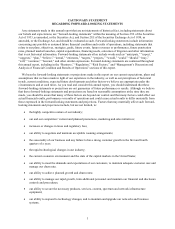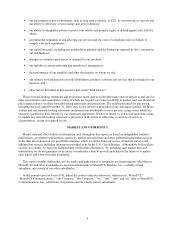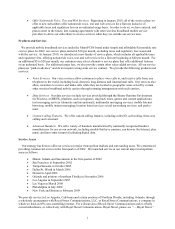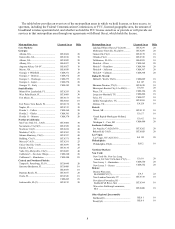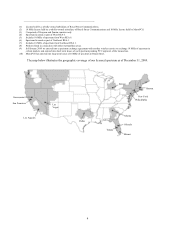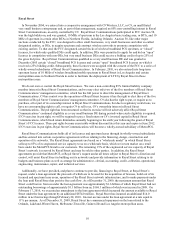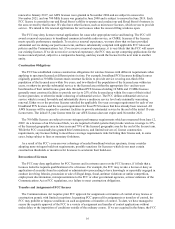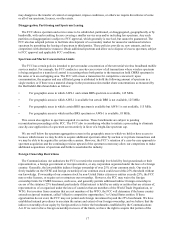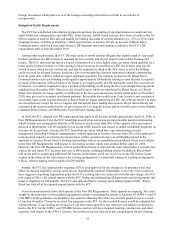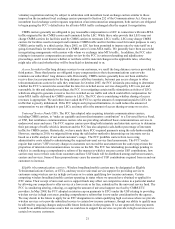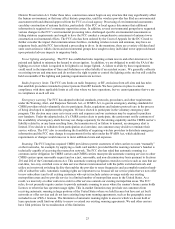Metro PCS 2009 Annual Report Download - page 25
Download and view the complete annual report
Please find page 25 of the 2009 Metro PCS annual report below. You can navigate through the pages in the report by either clicking on the pages listed below, or by using the keyword search tool below to find specific information within the annual report.13
Further, we also may face competition from new entrants and others using WiMax on exclusively licensed or
unlicensed spectrum. Additionally, we may compete in the future with companies that offer new technologies and
market other services we do not offer or may not be available with our network technology, from our vendors or
within our spectrum. Some of our competitors do or may bundle these other services together with their wireless
communications service, which customers may find more attractive. Energy companies, utility companies and
satellite companies also are expanding their services to offer telecommunications services.
There continues to be substantial merger and acquisition activity in the wireless industry. We have in the past
acquired, and may in the future acquire, spectrum to enter new metropolitan areas. We also may in the future
consider acquisitions of, or other business combinations with, companies in addition to acquisitions of spectrum. For
example, in 2007, we made a public proposal to merge with Leap, which we subsequently withdrew. In the future,
there could be discussions between us and other companies regarding potential acquisitions, divestitures, other
business combinations, or transactions between the companies.
Many of our competitors’ resources are substantially greater, and their market shares are larger, than ours. For
example, a number of our competitors have significantly greater spectrum and financial resources and human capital
than we do. Additionally, many of our wireless competitors offer larger coverage areas and nationwide calling plans
that do not give rise to additional roaming charges for their customers. Further, the marginal incremental cost of
some of our competitors may be substantially lower than our cost to provide service and may allow the competition
to price their services at rates that we cannot profitably provide. Many of our competitors offer service plans with
large bundles of minutes of use at lower per minute prices or price plans with unlimited nights and weekends and
some of our competitors offer unlimited service plans similar to ours. Our competitors’ plans could adversely affect
our ability to maintain our pricing, market penetration, growth and customer retention.
In addition, large national wireless broadband mobile services carriers have been reluctant to enter into roaming
agreements at attractive rates with smaller and regional carriers like us, which limits our ability to serve certain
market segments, and recent FCC actions to promote automatic roaming do not resolve these difficulties. This
competitive pressure also may increase as our basic service plans now include nationwide service.
The policies of the United States government have made, and may continue to make, additional spectrum for
wireless services available in each of our markets, which may increase the number of our competitors and enhance
our competitors’ ability to offer additional plans and services. Further, since many of our competitors are large
companies, they have on occasion been able to convince handset manufacturers to provide the newest handsets
exclusively to them. Further, at least one manufacturer of wireless products, Google, is selling its handsets directly
to the public without including service. Our competitors also can afford to heavily subsidize the price of a
subscriber’s handset because they have greater resources than us, a different business model than us, and may
require their customers to enter into long term contracts. The FCC has indicated it may examine, and Congress is
considering legislation that may limit, early termination fees for the long term contracts used by national wireless
broadband mobile services carriers, which could prompt them to reduce the subsidization of handsets and limit their
long term contracts.
All of these factors may detract from our ability to attract customers from certain market segments and may
require us to add additional features or services to our existing service plans, or make other changes to our service
plans.
Seasonality
Our customer activity is influenced by seasonal effects related to traditional retail selling periods and other factors
that arise from our target customer base. Net customer additions are typically strongest in the first and fourth
calendar quarters of the year. Softening of sales and increased customer turnover, or churn, in the second and third
calendar quarters of the year usually combine to result in fewer net customer additions during the second and third
calendar quarters. However, sales activity and churn can be strongly affected by the launch of new metropolitan
areas and areas surrounding our existing metropolitan areas, as well as promotional activity, which could reduce or
outweigh certain seasonal effects. For a more detailed discussion of seasonality in our business, please read
“Management’s Discussion and Analysis of Financial Condition and Results of Operations — Seasonality.”


